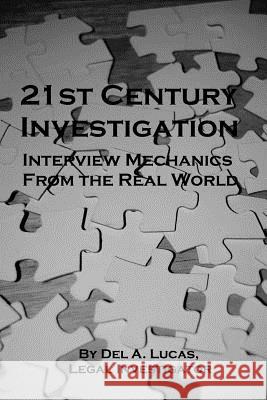21st Century Investigation: Interview Mechanics from the Real World » książka
21st Century Investigation: Interview Mechanics from the Real World
ISBN-13: 9781482309447 / Angielski / Miękka / 2013 / 268 str.
"21st Century Investigation: Interview Mechanics from the Real World," was conceived of, researched, and written from and for real life challenges. Within this, our 'Information Age', the role of the investigator, in all our various forms, is changing dramatically. Yet, within this age, our true importance is becoming ever more valuable. We are the human connection between the information and the people who need it. Now, more than any other time, the interview process needs to be learned and performed well, gathering all the possible information and gleaning the facts clear into the open air, to act as independent puzzle pieces within the context of the case. Learning the course of interviews is as much an internal study as any other. There are no machines to be trained on, no assembly lines, no final product other than those which we produce with our minds and abilities as communicators. This book was designed to provide the basic tools of the trade, as well as a clear glimpse into the world of the investigator. It is at once required to be both student and teacher, confidante, father confessor and executor of the facts. Perhaps the most difficult of all investigations to undertake is that of criminal defense. Every possible barrier is present; every tool to penetrate those barriers required. While this information may be colored toward the legal field, the ability to perform a proper interview will easily transpose to countless different professions, with a myriad of opportunities. Written in a comfortable, conversational style throughout, 'Interview Mechanics' begins with the foundation of any interview; basic communication. In the chapter 'The Verbal Communication Model', the academics of communication are hauled out for a serious work over. Some of the kinks manage to get smoothed out, while some new wrinkles are added to the overall mix. From there, 'The Investigator, Inside Out' goes through the mind set of the investigator, which points out several tradecraft basics which every investigator should be familiar with. Moving through the chapter, 'Interview Basics' are then reviewed, ending with 'Deception in the Interview', which revels in exposing the most obvious common sense. Since the majority of intelligent people have the greatest capacity to learn from involvement, a full case is taken up, from discovery on through to the final outcome. The case begins with an interview of the defendant, followed immediately by an analysis of that conversation. A crime scene review is performed, in conjunction with individual contacts with witnesses involved in the case. Continuing through the case, we interview several different personality types, analyzing each contact as we go along. Once the interviews are performed, and we have learned all we can, it becomes time to educate the lawyers. The chapter, 'Basic Investigation Report Writing' lays the ground work which is then explored quite completely in 'The Redbone Case Reports'. Through clear and elementary examples of written reports, the different issues which may arise are illustrated and resolved. At the close of the case we have covered a great distance. A virtual 'ride along' has been shared, and what would have taken several days of work is available to read and review at any point in time, as requirement may allow. From the ether mists of ideas, strategy, will and guile, we've moved from the fundamental communication model to having achieved the finish line in a criminal indictment. "21 Century Investigations: Interview Mechanics from the Real World" is one of a kind; a comfortable academic book which illustrates and illuminates the nuts and bolts of a very complex subject, presented in an entertaining manner from which anyone can benefit. Enjoy.
Zawartość książki może nie spełniać oczekiwań – reklamacje nie obejmują treści, która mogła nie być redakcyjnie ani merytorycznie opracowana.











